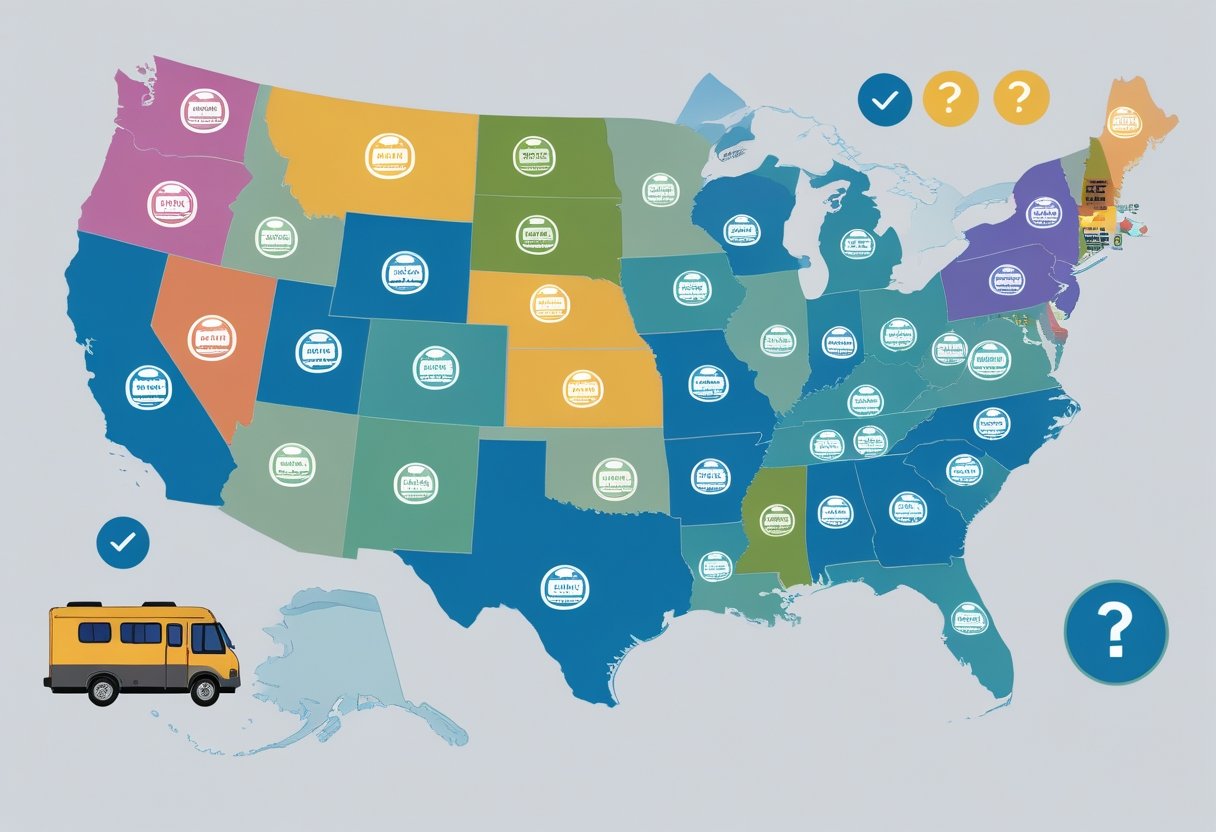Would you like to save this article?
Many RV enthusiasts wonder if their regular driver’s license is enough to hit the road in a recreational vehicle. The answer depends on several key factors that every potential RV driver should understand.
Most Class D license holders can legally drive RVs under 26,000 pounds, which includes the majority of recreational vehicles on the road today. This covers most Class B and Class C motorhomes, as well as many smaller Class A units.
Your standard license typically allows you to operate these vehicles without any additional endorsements or special permits. However, the rules become more complex when you consider larger RVs, different towing situations, and varying state regulations.
Understanding weight limits, commercial driver’s license requirements, and state-specific rules will help you determine exactly what you can drive with your current license and when you might need to upgrade.
Key Takeaways
- Your Class D license covers most RVs under 26,000 pounds without needing special permits
- Vehicles over 26,000 pounds may require a commercial driver’s license in certain states
- State regulations vary significantly, so checking your local DMV requirements is essential
Class D License and RV Eligibility
A Class D license is the standard driver’s license most Americans hold. This license type has specific weight limits that determine which RVs you can legally drive without additional endorsements.
Definition of Class D License
A Class D license is your regular, non-commercial driver’s license. This is the license you get when you first learn to drive.
The Class D license allows you to operate personal vehicles for non-commercial purposes. You cannot use this license to drive vehicles for business or to transport passengers for money.
Most states issue Class D licenses to drivers who pass basic written and road tests. The license covers standard cars, trucks, and many recreational vehicles.
Key features of Class D licenses:
- Non-commercial use only
- No special training required
- Valid for personal transportation
- Covers most everyday vehicles
Standard Weight Limits for Class D Use
Your Class D license covers recreational vehicles weighing under 26,000 pounds. This weight limit applies in most states across the country.
The 26,000-pound limit includes the vehicle’s gross vehicle weight rating (GVWR). You can find this rating in your RV’s owner’s manual or on a label inside the driver’s door.
Some states have additional restrictions beyond weight. A few states require special licenses for RVs over 40 feet long, regardless of weight.
Weight categories for Class D eligibility:
- Class B RVs: 6,000-8,000 pounds ✓
- Class C RVs: 10,000-12,000 pounds ✓
- Small Class A RVs: 13,000-25,999 pounds ✓
- Large Class A RVs: 26,000+ pounds ✗
Types of Recreational Vehicles Covered
Your Class D license covers most popular RV types. Camper vans fall well within the weight limits at 6,000-8,000 pounds.
Class C motorhomes typically weigh 10,000-12,000 pounds. These remain legal to drive with your standard license in all states.
Many Class A RVs also qualify for Class D operation. Smaller Class A models often weigh between 13,000-25,999 pounds.
RV types you can drive with Class D:
- Camper vans and Class B RVs
- Travel trailers (when combined weight stays under limits)
- Class C motorhomes
- Smaller Class A motorhomes under 26,000 pounds
Large luxury Class A RVs often exceed 26,000 pounds. These require special licensing in most states.
Weight Ratings and Their Impact on Legal Driving
Understanding weight ratings is crucial for determining whether your Class D license allows you to legally drive an RV. The 26,000-pound threshold serves as the primary dividing line between standard and special licensing requirements across most states.
GVWR vs. GCWR Explained
GVWR stands for Gross Vehicle Weight Rating. This is the maximum weight your RV can safely carry, including passengers, cargo, and fuel.
GCWR stands for Gross Combined Weight Rating. This applies when you’re towing a trailer behind your RV.
The GVWR only counts your motorhome’s weight. The GCWR includes both your RV and any trailer you’re pulling.
You can find your RV’s GVWR on a metal plate inside the driver’s door frame. This number never changes, even if your RV weighs less when empty.
Your actual weight might be lower than the GVWR. But legally, the GVWR is what matters for licensing requirements.
26,000 Pounds Threshold
The 26,000-pound limit is the key number for Class D licenses. If your RV’s GVWR stays under 26,000 pounds, you can drive it with a regular license in most states.
Going over 26,000 pounds typically requires a special license. Some states need a CDL. Others require a non-commercial special license.
Most Class A RVs weigh between 13,000 and 30,000 pounds. Class C RVs usually weigh 10,000 to 12,000 pounds.
Class B RVs are the lightest at 6,000 to 8,000 pounds. This means many larger Class A motorhomes will exceed the 26,000-pound limit.
You’ll need to check your specific RV’s GVWR before driving.
Towing and Combined Weights
When towing a trailer, the combined weight of both vehicles matters. Your Class D license typically allows towing up to 10,000 pounds.
The GCWR includes:
- Your RV’s actual weight
- Your trailer’s actual weight
- All passengers and cargo in both vehicles
If your combined weight exceeds 26,000 pounds, you may need a special license. Some states require a Class A license for heavy towing combinations.
A few states have different rules. Nevada requires a special endorsement for towing over 10,000 pounds, even if the total weight stays under 26,000 pounds.
Always check both your RV’s GVWR and your trailer’s weight before hitting the road.
When a CDL Is Required for RV Operation
A commercial driver’s license (CDL) is required in some states when your RV exceeds specific weight limits or length restrictions. Seven states and Washington D.C. require CDL certification for larger recreational vehicles.
CDL Requirements by State
Several states require you to obtain a CDL for RV operation under certain conditions. Arkansas requires a CDL for any vehicle over 26,000 pounds.
Connecticut, Hawaii, Kansas, New Mexico, and Washington D.C. follow similar rules. You need a Class B CDL for single vehicles over 26,000 pounds.
You need a Class A CDL for multiple vehicles with combined weight over 26,000 pounds. Wisconsin has different requirements.
You need a CDL for RVs over 45 feet in length, regardless of weight. Most other states do not require commercial licenses for RV operation.
Some states like California, Maryland, and Texas require special non-commercial licenses instead.
Class A, B, and C CDL Differences
Class A CDL allows you to drive combination vehicles with a total weight over 26,000 pounds. This includes large motorhomes towing heavy trailers or cars.
Class B CDL covers single vehicles over 26,000 pounds. This applies to large Class A motorhomes when driven without a towed vehicle.
Class C CDL is typically for vehicles carrying more than 16 passengers or hazardous materials. This rarely applies to standard RV operations.
The weight limits refer to the vehicle’s gross vehicle weight rating (GVWR), not the actual loaded weight.
State Differences and Special Considerations
RV license requirements vary significantly across states, with some requiring special licenses for vehicles over certain weights while others have no additional requirements. Your home state’s rules apply even when traveling to other states, making it essential to understand both local and destination regulations.
Variations in State Laws
State laws for RV licensing differ based on vehicle weight and type. Most states use the 26,000-pound threshold as their primary rule.
States requiring CDL:
- Arkansas: CDL for vehicles over 26,000 pounds
- Connecticut: Class B CDL for single vehicles over 26,000 pounds
- Hawaii: Class B CDL for single vehicles over 26,000 pounds
- Kansas: Class B CDL for single vehicles over 26,000 pounds
- Wisconsin: CDL required for RVs over 45 feet
States requiring non-commercial licenses:
- California: Class B license for RVs over 26,000 pounds or 40 feet
- Texas: Class B license for single vehicles over 26,000 pounds
- New York: “R” endorsement for vehicles over 26,000 pounds
Many states like Florida, Arizona, and Colorado have no special licensing requirements for recreational vehicles. These states allow Class D license holders to operate most RVs without additional permits.
Crossing State Lines with an RV
Your home state’s license requirements follow you across state lines. If your state requires a special license for your RV, you need that license in all states you visit.
For example, if you live in California and drive a large Class A RV, you need California’s Class B license even when traveling through states with no RV license requirements.
This rule works both ways. If your home state has no special requirements, you can drive your RV in stricter states using your regular Class D license.
However, you should check weight restrictions and any special rules in destination states. Some states have unique requirements that might affect your travel plans.
Wisconsin requires a CDL for RVs over 45 feet regardless of weight.
International Travel Considerations
Driving an RV internationally requires additional documentation beyond your regular license. Most countries require an International Driving Permit (IDP) along with your valid US license.
Canada accepts US licenses for short visits. An IDP is recommended for longer stays.
Your home state’s RV license requirements still apply when driving in Canada. Mexico requires an IDP for all foreign drivers operating recreational vehicles.
Some rental companies may have additional requirements or restrictions for international travel. European countries have strict weight and length limits for recreational vehicles.
Many European countries require special licenses for vehicles over 3,500 kilograms (about 7,700 pounds). This threshold is much lower than US standards.
Check with your destination country’s embassy or consulate for specific requirements before traveling internationally with an RV.






